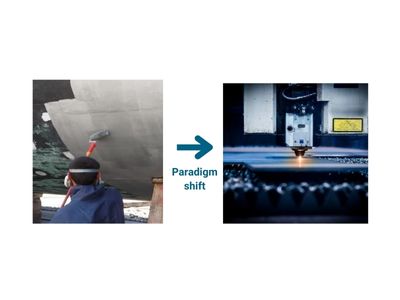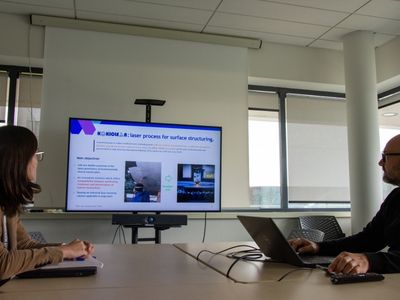KOKICLEAN – Eco-friendly marine coating
Developing and certifying a biomimicry shark skin antifouling treatment based on femtosecond laser texturing for boat paints.
Project Subject:
The KOKICLEAN project aims to offer manufacturers a means of protecting surfaces with eco-friendly antifouling paints through femtosecond laser texturing, with the aim of:
- Adding anti-biofilm properties to the latest generations of zero carbon marine paint.
- Creating an innovative and environmentally friendly solution that combines antifouling treatment and the preservation of marine ecosystems.
- Developing an industrial laser texturing solution applicable to large parts.
The main objective of the project is to demonstrate that it is possible to apply anti-Biofilm properties to the latest generations of eco-friendly and zero carbon marine paint, through the application of a laser texturing process with a femtosecond laser.
Today, the hulls of boats when submerged are subject to a natural phenomenon of biological fouling, called "bio-fouling", caused by the accumulation and growth of long lifespan marine organisms. When attached to the hulls these organisms form a heavy weight, increasing the boat’s mass and reducing the hull’s smoothness. Both factors increase drag during navigation. This accumulation of attached organisms can lead to overconsumption of fuel and increased maintenance costs. Moreover, it can cause the introduction of invasive alien species into marine environments.
To combat this phenomenon and its consequences, one solution consists of using antifouling paints. The vast majority of these paints contain biocides, the intention of which is to kill the living organisms which become attached to boat hulls. Each year 100,000 tons of this kind of antifouling paint is sold worldwide.
The environmental problems associated with the use of these paints have been well documented since the 1970s and are known in particular to disrupt the endocrine system of animals and inhibit photosynthesis. They are thus the cause of significant mortality in certain species of marine fauna and flora.
Therefore, the partners’ main goal is to meet the needs of manufacturers with an innovative device capable of responding to environmental issues while offering an effective antifouling system against the biological fouling of boat hulls. This promising device would be based on a technique that uses direct structuring via femtosecond laser, in which the micrometric structure is produced by direct radiation of the surface by ultra-short high-intensity laser pulses (with a femtosecond and picosecond laser pulse duration). This type of laser process has several advantages:
- It does not use polluting chemicals
- It is compatible with various materials: metals, glasses, crystals, polymers, organic materials, etc.
- It can be applied on surfaces with large (m²) dimensions
- The processing speed depends on the laser beam scanning speed and the average power of the laser source
In the long term, this project aims to develop a biomimicry and eco-friendly industrial solution for laser texturing that is applicable to large parts such as boat hulls using robotic instruments. This project is part of a groundbreaking approach using an innovative solution that allows consonance between antifouling treatment and the preservation of marine ecosystems.

ALPhANOV’s Role:
As part of this project, ALPhANOV will make its skills available to ETM during the implementation of high-productivity laser texturing processes by providing laser rendered surface structuring.
ALPhANOV has developed, within the framework of a European project (TRESCLEAN), a laser texturing process aimed at creating biological anti-contamination surfaces on metal molds of composite parts for washing machines. (https://www.tresclean.eu/). A mold piece of about 1m² was textured using a laser process in less than 10 minutes, and project partners showed that the antibacterial properties of the mold surface were transferred to the plastic polymer during molding.
Partners:
Funding:
Région Nouvelle-Aquitaine